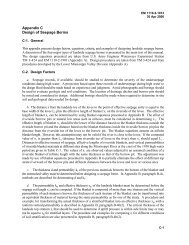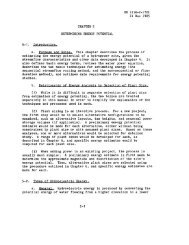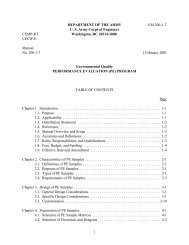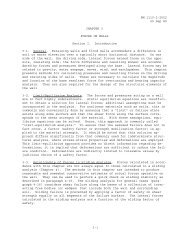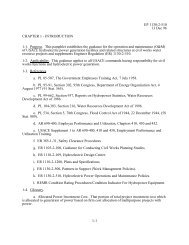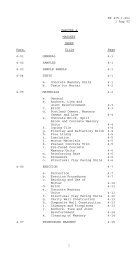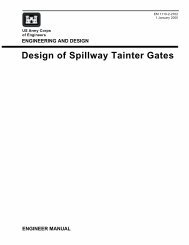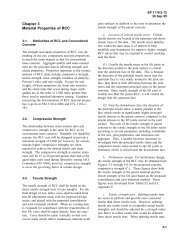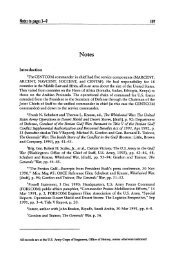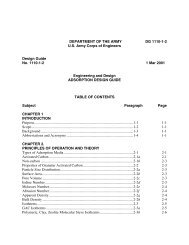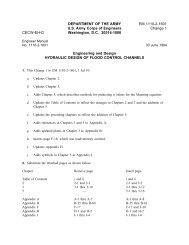Earthquake Design and Evaluation of Concrete Hydraulic Structures
Earthquake Design and Evaluation of Concrete Hydraulic Structures
Earthquake Design and Evaluation of Concrete Hydraulic Structures
Create successful ePaper yourself
Turn your PDF publications into a flip-book with our unique Google optimized e-Paper software.
EM 1110-2-6053<br />
1 May 2007<br />
increment is evaluated on the basis <strong>of</strong> an assumed response mechanism. The advantage <strong>of</strong> this<br />
method is that it can be used for both linear <strong>and</strong> nonlinear analyses. In the case <strong>of</strong> nonlinear<br />
analyses, structure properties (including nonlinear behavior) can be modified during each time<br />
increment to capture response behavior appropriate to that deformed state. The application <strong>of</strong><br />
nonlinear analysis to concrete hydraulic structures is limited to cases for which experimental or<br />
observational evidence <strong>of</strong> nonlinear behavior is available <strong>and</strong> that validity <strong>of</strong> the numerical<br />
models have been demonstrated. These include certain nonlinear behavior such as joint<br />
opening mechanisms in arch dams, tensile cracking <strong>of</strong> gravity dams, sliding <strong>and</strong> rotational<br />
stability <strong>of</strong> blocks isolated by opened joints <strong>and</strong> cracked sections, <strong>and</strong> yielding <strong>and</strong> cracking <strong>of</strong><br />
free-st<strong>and</strong>ing intake towers.<br />
4-3. Modeling <strong>of</strong> Structural Systems<br />
a. Structural models. Structural models for dynamic analyses are developed much in the<br />
same manner as for static analyses. However, distribution <strong>of</strong> mass <strong>and</strong> stiffness <strong>and</strong> dynamic<br />
interaction between the structure <strong>and</strong> water <strong>and</strong> between the structure <strong>and</strong> foundation as well<br />
as with the backfill soil should be established accurately. The response <strong>of</strong> a structure under<br />
severe ground shaking may approach or exceed the yield/cracking state. This means that in a<br />
linear-elastic dynamic analysis the use <strong>of</strong> effective stiffness (Paragraph 4-4) is more appropriate<br />
than the initial elastic stiffness used in the static analysis, <strong>and</strong> that the damping should be<br />
selected consistent with the expected level <strong>of</strong> deformation <strong>and</strong> the extent <strong>of</strong> nonlinear behavior.<br />
Furthermore, concrete deterioration <strong>and</strong> cracking can reduce structural stiffness <strong>of</strong> an existing<br />
structure; thus these effects should be considered in estimation <strong>of</strong> a representative effective<br />
stiffness. The dynamic interaction with the foundation introduces flexibility at the base <strong>of</strong> the<br />
model <strong>and</strong> could provide additional damping mechanisms through material <strong>and</strong> radiation<br />
damping. Various foundation models suitable for concrete hydraulic structures are discussed in<br />
Paragraph b below. A hydraulic structure also interacts with the impounded, surrounding, or<br />
retained water through hydrodynamic pressures at the structure-water interface. This interaction<br />
is coupled in the sense that motions <strong>of</strong> the structure generate hydrodynamic pressures that<br />
affect deformations (or motions) <strong>of</strong> the structure, which in turn influence the hydrodynamic<br />
pressures. Various structure-water interaction models with varying degrees <strong>of</strong> sophistication are<br />
described in Chapter 2 <strong>of</strong> EM 1110-2-6051. They include models as simple as the added-mass<br />
concept to more vigorous finite-element formulation that accounts for water compressibility <strong>and</strong><br />
boundary absorption effects. Often structure-foundation interaction <strong>and</strong> structure-water<br />
interaction effects can be accommodated in the special finite-element models developed for<br />
gravity <strong>and</strong> arch dam evaluation. Since foundation properties, structural properties, <strong>and</strong><br />
boundary conditions can vary, it is advisable to systematically vary parameters that have a<br />
significant effect on structure response until the final results cover a reasonable range <strong>of</strong><br />
possible responses the structure could experience during the design earthquake. Properties <strong>of</strong><br />
concrete for use in seismic analysis are described in Chapter 5. Following is a brief description<br />
<strong>of</strong> structural idealization for seismic analysis <strong>of</strong> concrete hydraulic structures. For detailed<br />
discussions <strong>and</strong> more information refer to EM 1110-2-6050, EM 1110-2-6051, <strong>and</strong> respective<br />
manuals for a particular structure.<br />
(1) A variety <strong>of</strong> models are used to represent different types <strong>of</strong> hydraulic structures or to<br />
capture certain modes <strong>of</strong> behavior. For example, the model may be as simple as a rigid block to<br />
perform sliding stability analysis <strong>of</strong> a dam section (Figure 4-1), a frame model to compute<br />
earthquake response <strong>of</strong> a freest<strong>and</strong>ing intake tower, a 2D finite-element mesh for stress<br />
analysis a gravity dam, or a more elaborate 3D finite-element mesh with nonlinear joint<br />
elements to simulate contraction joints opening in an arch dam (see example in Appendix F).<br />
4-6




